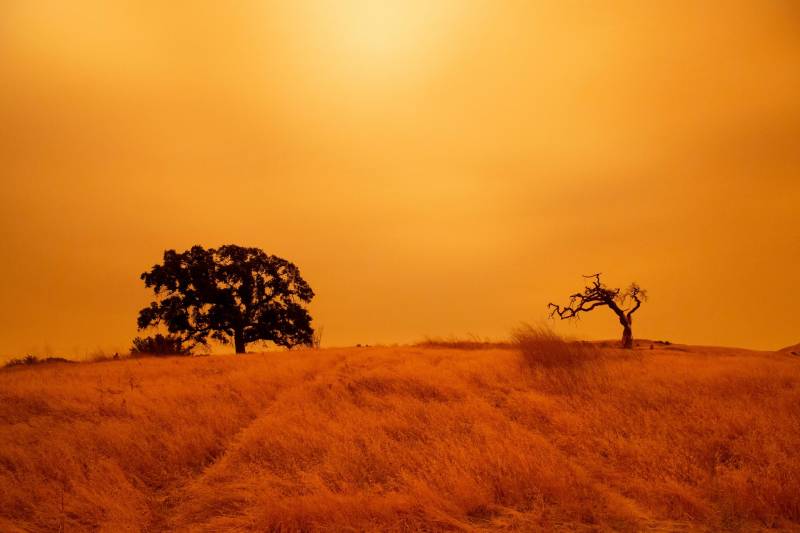No doubt you remember the day of the orange night last fall, when wildfire smoke filled the sky over the Bay Area. A recent study out of Stanford University suggests that exposure to that kind of smoke or air pollution can harm children’s immune and cardiovascular systems.
Dr. Mary Prunicki is the lead author of that study, as well as the director of air pollution and health research at Stanford’s Sean N. Parker Center for Allergy & Asthma Research. Danielle Venton is a science reporter for KQED. They both spoke with KQED’s Brian Watt recently about children and smoke.
The following has been edited for length and clarity.
What did your study find?
Mary Prunicki: Our study looked at over 200 children that live in the Central Valley. These kids were 6-8 years old, living in Fresno, which is consistently one of the top four cities for poor air quality in the nation.
We looked at the blood and the levels of pollution these children were exposed to at different points in time. We found that the immune system showed signs of being dysregulated, with different balances of immune cells than we typically would see in a healthy individual.
We also found that blood pressure was associated with exposure to pollution, specifically diastolic blood pressure, which is the bottom number. While this is interesting, we’ll need to replicate it with future studies, because the few studies that have come out about children and blood pressure have been relatively inconsistent. But we’ll certainly be anxious to see where this goes.
How long do kids need to be exposed to bad pollution or wildfire smoke to be affected?
MP: Unfortunately, the impact can occur in as short as a day. We know that chronic exposure certainly impacts health, but we found associations with even one day of pollution exposure. That is certainly startling, especially for this age group.
What can we do to protect children?
MP: When we’re talking about wildfire smoke, unfortunately we need to keep them indoors as much as possible. If the kids need to go outside and burn off some energy, it’s always good to check the AQI level and try to pick a time of day when it seems to be the lowest.
When they do go outside, try to get them to not be as physically active as they normally would. If they have respiratory conditions like asthma, make sure that their inhalers are refilled and ready to go. Talk to their school about how they are planning to handle the exposure to the smoke.
And finally, support prescribed burning, which will reduce overall our exposure to wildfire smoke in the future.
In California, we talk a lot about ways to make wildfires less smoky. Does that mean doing more prescribed burns?
Danielle Venton: It does. In California, there’s about 15 million acres of land that are overgrown and at risk for wildfires. Those 15 million acres need some sort of management to be brought back into balance and to become more fire resilient.
The best, the least expensive, the most scalable tool for that is managed fire. That’s how Native American tribes managed their lands for many thousands of years.
But more prescribed fires would mean more smoke, right?
DV: That’s right, but we are going to have smoke either way. We can choose how bad it will be. We should think of prescribed fire as a good trade-off.
Out of control, catastrophic wildfires bring us days or weeks of really toxic smoke. When fires get out of control, they’re burning buildings and cars, putting really bad stuff in the air.
Prescribed fires are only burning vegetation — ideally only grasses, brush and small trees. The smoke is not as toxic. It’s not as thick. And burns can be timed for when the smoke will clear out of an area relatively quickly.
And we should remember that every controlled burn reduces the risk of a future catastrophic, out-of-control fire.
Dr. Prunicki, you’ve recently studied the impact of prescribed fire smoke versus wildfire smoke on kids, right?
MP: That’s correct. We actually looked at a subset of the children that I just mentioned. Some had been exposed to a prescribed fire in Yosemite at least 90 days prior to the blood draw we did, where other kids had been exposed to a wildfire in Yosemite 90 days prior to their blood draw. These kids were at least 60 miles away from where the smoke is coming from.
What we found is that the prescribed burn had less of an impact on immune systems than the wildfire smoke. And that makes sense from what we know from other wildfire studies and from air pollution studies.
How should Californians be thinking about this? How should we be changing our behavior as we are exposed to what seems to be increasing wildfire smoke?
DV: I think it’s useful to keep in mind that air quality managers are very sensitive to people who call and complain about prescribed fire smoke. Just the worry that seeing some smoke in the air will upset people has canceled some burns that otherwise would have gone ahead.
One thing we can do is encourage our local and regional officials to enable more good fire, more prescribed fire, knowing that it helps prevent future bad fires.

